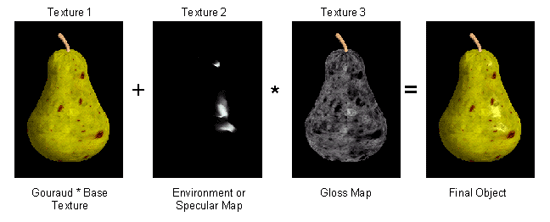Pixel
Tapestry
ATI
took a slightly different approach to speed when designing the Radeon core. The
Radeon uses 2 pixel pipelines with 3 texture units per pipeline, rather than the
traditional 2 texture units per pipeline. This allows the Radeon to apply 3 textures
per pixel in a single clock without a performance hit, the downside of this is
that one texture unit sits idle when only using 2 textures per pixel. Thus
when 3 textures are used the Radeon outputs 6 texels per second, but falls to
4 when only 2 textures are used because only two of the texture units are used
in each pipeline. Running at 166MHz, the Radeon has a peak fillrate of 996MegaTexels
per second when using 3 textures per pixel, and falling to 664MegaTexels if 2
textures are used.
This
design gives the Radeon a distinct advantage when working with 3 textures per
pixel, unfortunately currently most games and applications only use 2. This means
the Radeon's peak fillrate is cut to 664MegaTexels, giving the GeForce2 cards
a real advantage as the GTS's 4 pixel pipelines push out 1,600MegaTexels per second.
|
| |
Radeon |
GeForce256 |
GeForce
GTS |
|
Clock
Speed | |
166MHz |
120MHz |
200MHz |
| Rendering
Pipelines | |
2 |
4 |
4 |
| Texture
units per pipeline | |
3 |
1 |
2 |
| Single
Texture Fillrate |
MPixels/sec |
332 |
480 |
800 |
|
|
MTexels/sec |
332 |
480 |
800 |
| Dual
Texture Fillrate |
MPixels/sec |
332 |
240 |
800 |
|
|
MTexels/sec |
664 |
480 |
1600 |
| Triple
Texture Fillrate |
MPixel/sec |
332 |
120 |
400 |
|
|
MTexels/sec |
996 |
360 |
1200 |
Here
we see a comparison between the Radeon and nVidia chipsets. As we see in the chart,
the Radeon does not take a hit in performance until using more than 3 textures,
but the GTS takes a 25% performance hit when rendering more than 2 textures. This
means that the Radeon will likely perform quite closely to, if not above the GTS
cards when triple texturing games hit the market.
Since
graphics chipsets began using 3 texture units per pipeline, the term of megatexels
per second has become largely inaccurate. Megatexels takes into account the number
of textures being applied per pixel, but with graphics chipsets now having three
texture units per pipeline, one cannot accurately compare two chipsets based on
their Megatexel fillrates.

It
should be noted that this graph represents only MegaPixel fillrates at equal clock
rates and number of rendering pipelines.

A visual layout of the
Radeon core.
When working
with 3 textures per pixel, chips with only 2 texture units per pipeline
must:
| 1)
Make multiple passes per pixel, 3 in the case of a single texture unit per pipeline
design |
| 2)
Use multiple pipelines per pixel |
In
the case of the GeForce, 2 pipelines are used to render each pixel, one pipeline
renders 2 textures, and the other renders only 1. ATI is hoping that games start
using 3 textures soon as this is where the Radeon holds an advantage over other
chips. Here is a nice example of how developers can make use of the 3 texture
units to create extremely detailed textures.

The second
component of ATI's Pixel Tapestry technology is 3D texture support. Currently
all 3D images are made by "wrapping" a flat 2d texture over a
3 dimensional mesh. Imagine that you have a block of wood, using 2D textures,
the flat textures are stretched over a 3D mesh. If I then cut a corner off
the block, the engine must reshape the block and then apply a flat texture
to the newly exposed area to create the illusion of seeing the inner grain.
With 3D textures, when I cut the corner off, an inner portion of the 3D
texture is exposed. This means that we can create much more realistic looking
objects, and save the developers some time trying to create all the textures
for when objects are modified.
The
third component I would like to touch on is ATI's Full Screen Anti-Aliasing. When
one draws a diagonal line using a grid of pixels, the result looks somewhat like
a staircase. The need for FSAA has really became apparent in the last year or
so with high quality 3D rendering engines being produced, but no way to reduce
the staircase and popping effects that small objects display when viewed at a
distance.
In
recent months 3DFX introduced it's T-Buffer technology on the Voodoo 5 series
which was able to provide both 2 and 4 sample FSAA in hardware. Although there
is a huge performance hit, the image quality improves tremendously, and both nVidia
and ATI quickly followed suit with FSAA drivers. ATI uses the exact same accumulation
buffer FSAA technique that 3DFX introduced on the Voodoo5 series.
There
is a lot more to the Pixel Tapestry architecture that we have discussed here,
but that is slightly out of the scope of this review. For more information, please
view ATI's
technical papers on the Radeon.